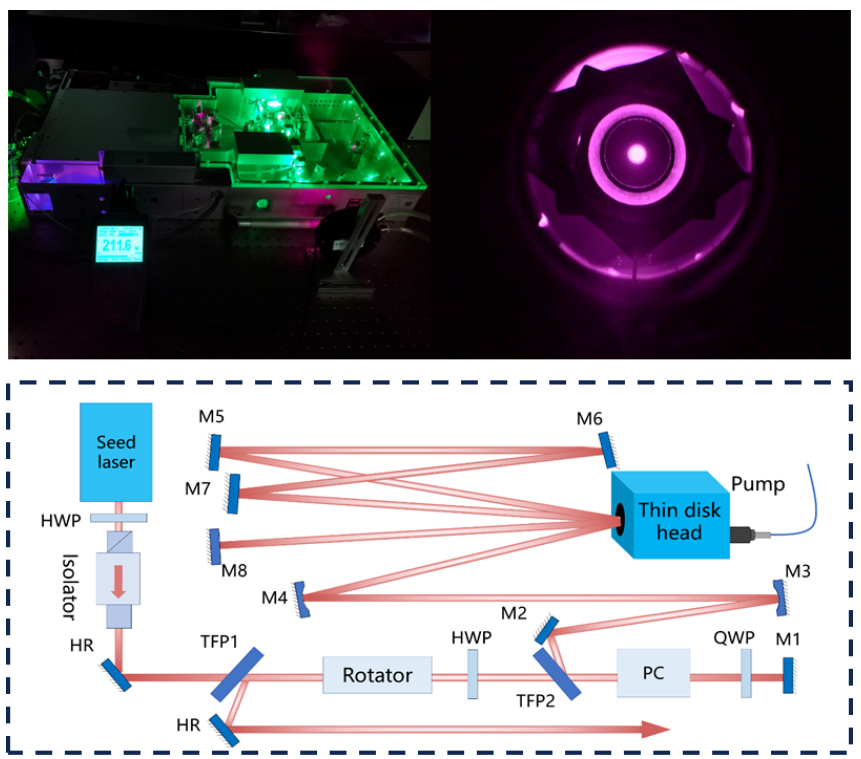High performance ultrafast wafer laser technology
High-power ultrafast lasers are widely used in advanced manufacturing, information, microelectronics, biomedicine, national defense and military fields, and relevant scientific research is vital to promote national scientific and technological innovation and high-quality development. Thin-slice laser system with its advantages of high average power, large pulse energy and excellent beam quality has great demand in attosecond physics, material processing and other scientific and industrial fields, and has been widely concerned by countries all over the world.
Recently, a research team in China has used self-developed wafer module and regenerative amplification technology to achieve high-performance (high stability, high power, high beam quality, high efficiency) ultra-fast wafer laser output. Through the design of the regeneration amplifier cavity and the control of the surface temperature and mechanical stability of the disc crystal in the cavity, the laser output of single pulse energy >300 μJ, pulse width <7 ps, average power >150 W is achieved, and the highest light-to-light conversion efficiency can reach 61%, which is also the highest optical conversion efficiency reported so far. The beam quality factor M2<1.06@150W, 8h stability RMS<0.33%, this achievement marks an important progress in high-performance ultrafast wafer laser, which will provide more possibilities for high-power ultrafast laser applications.

High repetition frequency, high power wafer regeneration amplification system
The structure of the wafer laser amplifier is shown in Figure 1. It includes a fiber seed source, a thin slice laser head and a regenerative amplifier cavity. A ytterbium-doped fiber oscillator with an average power of 15 mW, a central wavelength of 1030 nm, a pulse width of 7.1 ps and a repetition rate of 30 MHz was used as the seed source. The wafer laser head uses a homemade Yb: YAG crystal with a diameter of 8.8 mm and a thickness of 150 µm and a 48-stroke pumping system. The pump source uses a zero-phonon line LD with a 969 nm lock wavelength, which reduces the quantum defect to 5.8%. The unique cooling structure can effectively cool the wafer crystal and ensure the stability of the regeneration cavity. The regenerative amplifying cavity consists of Pockels cells (PC), Thin Film Polarizers (TFP), Quarter-Wave Plates (QWP) and a high-stability resonator. Isolators are used to prevent amplified light from reverse-damaging the seed source. An isolator structure consisting of TFP1, Rotator and Half-Wave Plates (HWP) is used to isolate input seeds and amplified pulses. The seed pulse enters the regeneration amplification chamber via TFP2. Barium metaborate (BBO) crystals, PC, and QWP combine to form an optical switch that applies a periodically high voltage to the PC to selectively capture the seed pulse and propagate it back and forth in the cavity. The desired pulse oscillates in the cavity and is amplified effectively during the round trip propagation by finely adjusting the compression period of the box.
The wafer regeneration amplifier shows good output performance and will play an important role in high-end manufacturing fields such as extreme ultraviolet lithography, attosecond pump source, 3C electronics, and new energy vehicles. At the same time, the wafer laser technology is expected to be applied to large super-powerful laser devices, providing a new experimental means for the formation and fine detection of matter on the nanoscale space scale and femtosecond time scale. With the goal of serving the major needs of the country, the project team will continue to focus on laser technology innovation, further break through the preparation of strategic high-power laser crystals, and effectively improve the independent research and development capability of laser devices in the fields of information, energy, high-end equipment and so on.
Post time: May-28-2024





